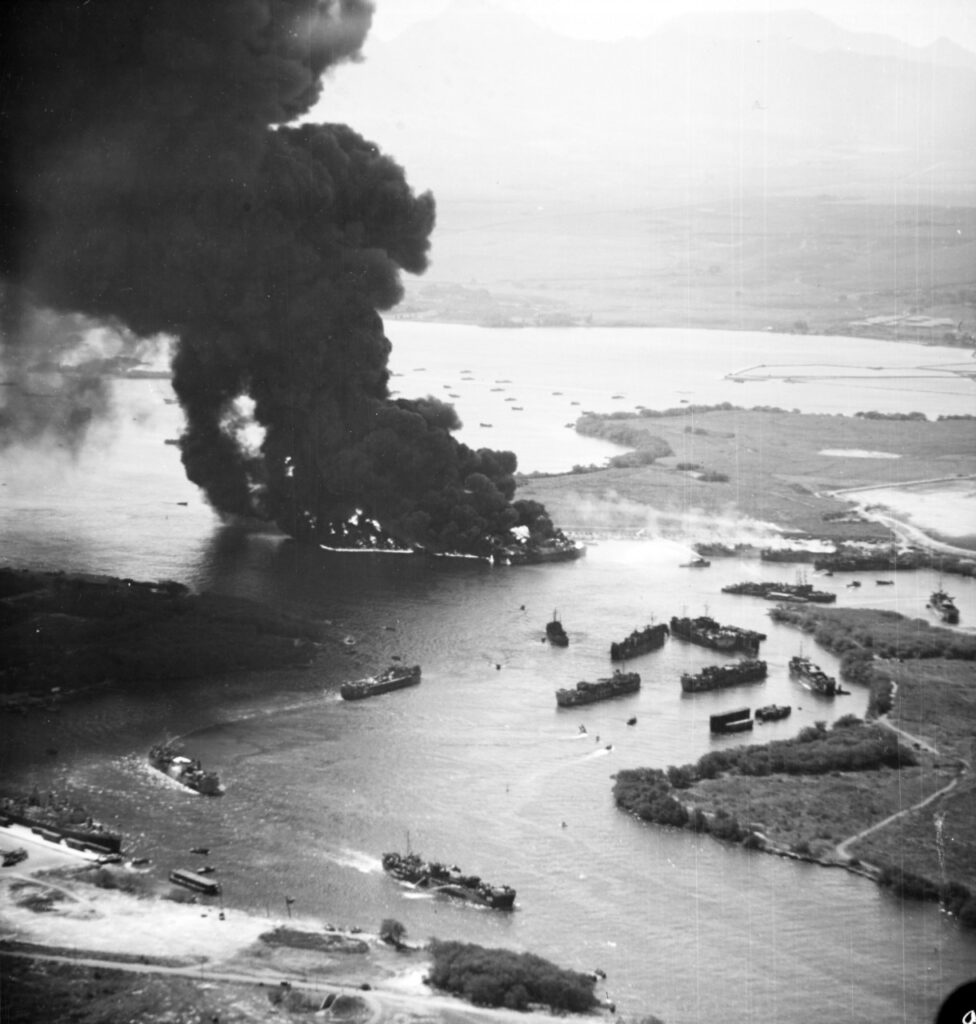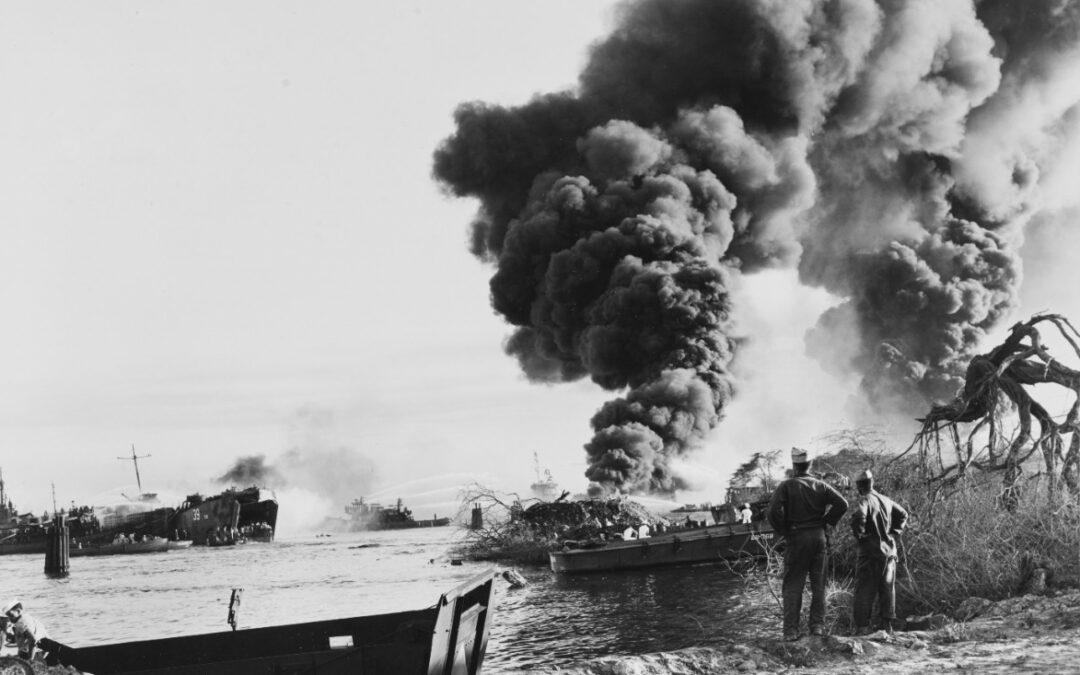By Naval History and Heritage Command.
May 21, 1944
Pearl Harbor contains three subareas, or “lochs,” named East, Middle, and West. On Dec. 7, 1941, East and Middle Lochs exploded in flames during the Japanese air attacks that brought the United States into World War II. West Loch, spared from destruction at the hands of the enemy, fell victim three-and-one-half years later to a spectacular and devastating ordnance accident.
Since the U.S. entry into World War II, West Loch had harbored, in addition to Navy and civilian vessels, large stores of ammunition, fuel, and other material. On May 21, 1944, the various berths were housing 29 LSTs (tank landing ships), each as long as a football field. Preparations were almost complete for the journey to Saipan, the invasion of which was scheduled for June 15.
“To say that the LSTs were combat loaded is a euphemism,” writes historian Howard E. Shuman. Rather, “they were floating ammunition dumps, floating gasoline storage tanks, floating vehicle garages, floating ship repair yards, and floating overcrowded hotels.”
The First Three Explosions
At berthing station T-8 on the afternoon of May 21, one of these ships—LST-353—appeared to spontaneously combust. “There was a terrific explosion,” according to Paul E. Cooper, a Marine on board a neighboring LST.
From the deck of LST-353, shrapnel shot out in all directions, and burning debris fell from the sky. Blast forces flung men off their feet and into the sea. High-octane gasoline spilled into the water and ignited. Fires broke out on neighboring LSTs.
“I thought my head had blown off,” recalls William L. C. Johnson, a pharmacist’s mate on the tank deck of nearby LST-69.
At the next berthing area over, T-9, LSTs began to flee the area. Some tried to get to a far corner of the loch, while others set course for open sea. Amid the confusion, no one had made it very far when the second, larger explosion came—just three minutes after the first.
Cooper had been ordered to keep the Marines on his LST below decks to protect them from falling debris but, when the second explosion hit, “all these men I was trying to keep [inside] came running through the door at the same time. I got knocked down as they went over the side into the water.”
Meanwhile, Johnson, having departed his LST in a small landing craft, was busy trying to pull men out of the water. But with the second explosion, which “threw equipment, men, and shrapnel all over the harbor,” Johnson recalls, “I dove into the water and held my hands over my head.”
The LSTs at berths a little farther away started to leave West Loch. Closer to the explosions, however, raging fires blocked crews’ access to the forward lines, which kept the LSTs moored in the developing conflagration. The heat and subsequent explosions pushed survivors aft, onto the fantails, and eventually into the fiery water.
At berthing area T-8, where the disaster had started, one of the LSTs, either adrift or under command of someone steering it toward safety, severed the lines of another LST before beaching itself 200 yards away. Two more LSTs from T-8 followed. Five others, their lines somehow cut, began to drift southward.
And now a third explosion, perhaps the largest, issued from one of these LSTs. Sound waves traveled as far as 15 miles. Flaming debris came down in a 3,000-foot radius. As the sky rained fire, LSTs at the rest of the berthing areas began to get underway.
Drifting Infernos
To make matters even worse, one of the burning, exploding LSTs drifted over to the next berthing area, T-9, and ignited yet another tank landing ship.
The situation continued to deteriorate. “The smoke was so thick, you couldn’t see much in any direction,” Cooper recalls. Landing Crafts for Tanks (LCTs) and other small vessels cut through the water, but their skippers had trouble seeing men amidst the smoke and flames. According to Cooper, some of the men in the water, still alive, ended up “run over by the boats trying to rescue them.”
At about the time of the third explosion, LCMs (landing craft, mechanized) with fire pumps departed East Loch for West Loch, while fireboats at Honolulu Harbor—14 nautical miles away—sped toward the disaster. Meanwhile, tugs and a few fireboats at West Loch were trying to tow the ships apart and douse the flames, but to no avail.
At 4:50 p.m., LST-353, site of the first explosion and now adrift and in flames, sank. Other LSTs remained on the surface as burning, exploding specters of further destruction.
At the southern shore of the loch stood a massive ammunition depot, where the cargo ship Joseph B. Francis was unloading 350 tons of ammunition. Out of nowhere, it seemed, a phosphorous shell landed on her deck and detonated. The crew extinguished the fire in short order, but the shell reignited some minutes later, and the fires had to be fought anew. Still, Joseph B. Francis managed to escape the scene and destruction.
But the ammunition depot now stood in the way of three floating infernos: LST-43, LST-179, and LST-69, which shuddered and lifted out of the water as a sudden explosion sent a fireball into the air. As the LSTs lumbered toward the facility, the fires on board crept higher and burned hotter. Explosions continued to issue from the decks and from deeper within the ships. Personnel at the depot braced themselves for the worst.
Mercifully, the ships came to a stop just 500 feet away from the ammunition depot.
The explosions continued for hours. Shortly before 10p.m., when things seemed to be under better control, LST-39 caught fire again. At 1:30a.m., LST-480 reignited. And even as late—or early—as 5:10a.m. on the following day, May 22, the Pearl Harbor signal tower was reporting fire and smoke in the direction of West Loch.
By 8 a.m., finally, all of the fires were either out or contained, though some ships kept burning for days.
The Aftermath
With two thirds of personnel on shore leave when the initial explosion occurred, the death toll was nonetheless staggering. Samuel Eliot Morison, historian of naval operations during World War II and one of the first people to write about the disaster, puts the death toll at 163. A further 396 sustained injuries, many of them excruciating and grievous. The scattering of ships and the departure for the Marianas a few days later meant that precise counts of casualties among Army, Navy, Coast Guard, and Marine Corps were impossible to compute.
We know much more about the material losses: 6 LSTs, 3 LCTs, 17 amphibious tractors, and 8 Howitzers, to name just the greatest losses. Another two LSTs were so damaged, they could not be used for the invasion of Saipan.
And yet, for the crucial Saipan operation, there was no delay as a result of the disaster at West Loch. Reserve LSTs appeared in short order, and the survivors of West Loch arrived at Saipan on schedule. There, they saw a familiar sight, according to Cooper: “landing craft turned upside down on the reef. . . [and] all sorts of vehicles and equipment on fire. The dead and wounded were. . . everywhere.” This time, however, the cause was clear—Japanese resistance to the American onslaught.
Lessons
There is no consensus on what caused the first explosion at West Loch, which set off the sequence of events that produced one of the greatest non-combat disasters in U.S. history.
Evidence after the fact, including eyewitness reports, shows plenty of risk factors. Men were seen smoking cigarettes near gasoline drums. Welding had been underway on deck. A Navy intelligence report hypothesized a dropped mortar shell. The mystery endures because no one close enough to the initial blast survived to give account of what he saw.
Nevertheless, the West Loch disaster proved that it is indeed possible to learn from an event, the causes of which are still a mystery. The Navy took three crucial lessons and implemented directives based on the knowledge that the West Loch disaster afforded.
The first lesson: Facilities for loading gasoline and facilities for loading ammunition must be kept separate. Secondly, safety precautions, such as smoking bans, must be enforced with the utmost rigor. And finally, mooring berths, especially for LSTs, must be designed in such a way as to minimize the risk of fire and maximize the chances of escape.
—Adam Bisno, PhD, NHHC Communication and Outreach Division, May 2019


